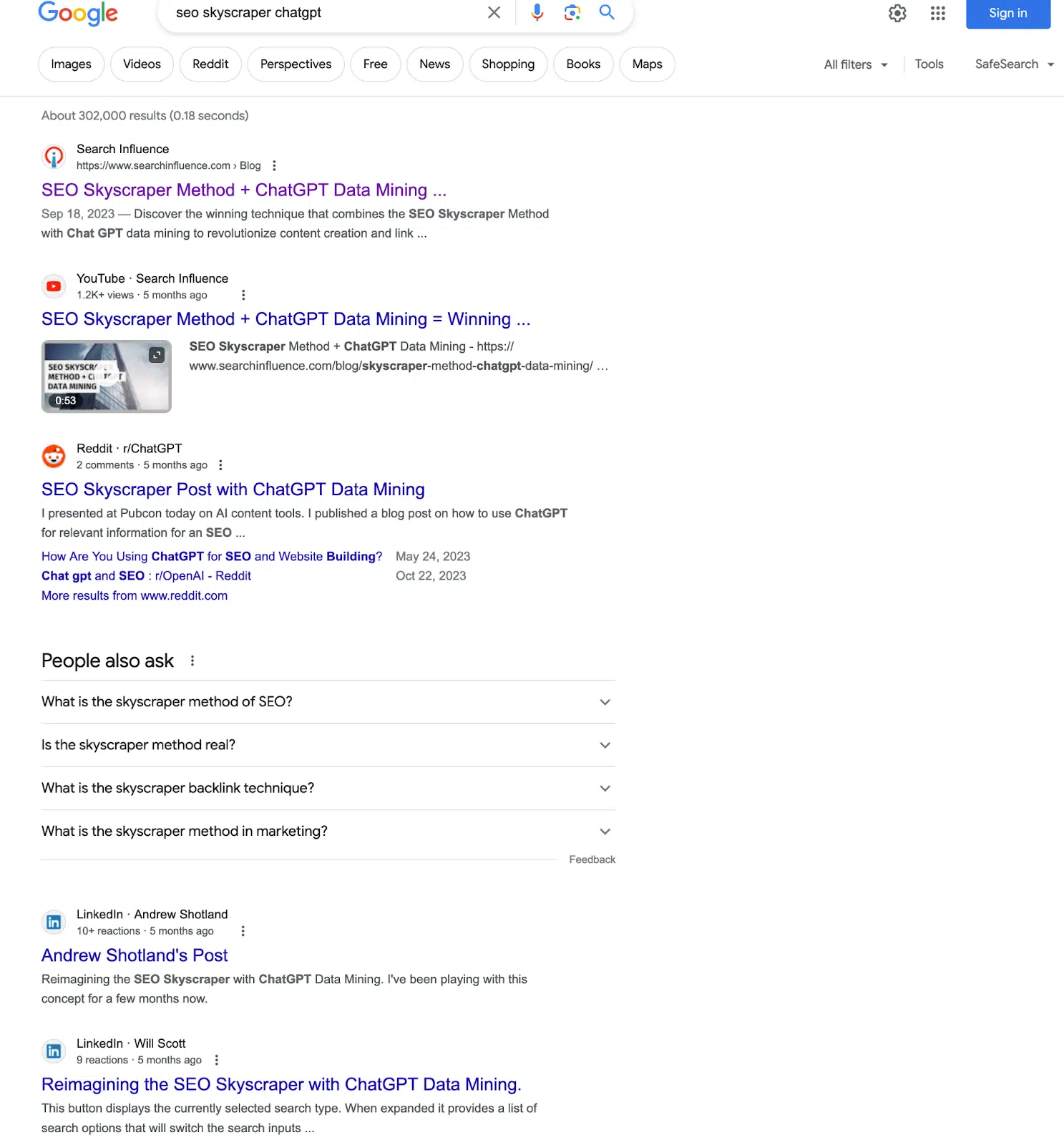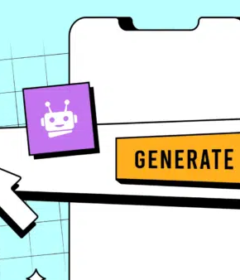Repurposing content with AI: Streamlining blog roundups and skyscraper posts

Learn an AI-assisted approach to content repurposing, enabling you to efficiently create blog roundups and skyscraper posts.
In the old days, humans had to identify sources, summarize the work and search for common meaning. Today, robots do the heavy lifting and you, the human, are left to do the creative work of prompting and interpreting the output for the rest of us.
My tagline for the foreseeable future is:
“I’m human. I’m helpful. Some of this is AI, and that’s OK.”

This article explores how you can leverage AI tools to streamline the process of creating blog roundups and skyscraper posts – two effective content formats that, done well, can earn prominent positions in search results pages and drive traffic.
We’ll also dive into:
- The concept of the “AI sandwich” which combines human expertise with the power of AI to produce trustworthy, helpful content.
- A range of AI tools specifically designed for content creation, image generation and video production to incorporate into your workflow.
What are blog roundups and skyscraper posts?
Simply put, a roundup article is a blog post or article that includes multiple other sources to form the article’s content. The contributing content is typically on a fixed theme or topic.
Traditionally, the roundup post may be built on direct contributions from industry experts or may be made up of content repurposed from existing articles.
LinkedIn has gone so far as to institutionalize this through Collaborative articles.
LinkedIn selectively invites experts to contribute to their articles based on their professional background, skill proficiency and engagement on the platform.
From a user perspective, a roundup blog post brings together multiple expert views of a topic.
From an SEO or marketing perspective, roundup posts align the publisher with both the topic of the article and the contributors.
Meanwhile, the “skyscraper technique” was popularized by Brian Dean at Backlinko. The steps involved are:
- Step 1: Find link-worthy content.
- Step 2: Make something even better.
- Step 3: Reach out to the right people.
Dean approaches the skyscraper as a link building technique.
In my initial approach, I received feedback that what I was doing was more of a “roundup.” And that’s OK, too. Whether it’s a roundup, a skyscraper, or a review, the real value is that you are learning from the pages, winning your SERP and repurposing content to improve upon them.
As search engines move from lexical to semantic search, the skyscraper technique becomes as much about including known entities as its linkworthiness.
If well executed, the skyscraper includes several chunks, also known as passages and, if you’re Cindy Krum, “fraggles.” Passages are particularly important in Google’s SGE and rich snippets as they’re often the part of the page included in the rich results.
This podcast episode with Michael King of iPullRank and Martha van Berkel of Schema App offers a great explanation of semantic search, the knowledge graph and their potential implications for SGE.
Repurposing content with AI can make the workflow for blog roundups and skyscraper posts much more efficient.
Dig deeper: Using generative AI to improve existing content: Top tips + sample prompts
AI sandwich: The process of building helpful content with AI and human input

There are concerns that using AI tools will lead to content being deemed “unhelpful.” To support the quality guidelines and their human raters, the best use of AI tools may be an “AI sandwich” where:
- Humans write prompts.
- AI does its thing.
- Then humans edit and fact-check.
If we want to produce helpful, trustworthy content, the output of the AI content generation tools will need to be like a kit of parts on the shelf that together make the whole.
Below is a process for repurposing content with AI:
- Step 1: Identify the content you want to reference.
- Who ranks? This is where a tool like Surfer SEO comes in handy.
- Step 2: Have the tools summarize the reference articles.
- Do it one by one in ChatGPT, Gemini, etc., or do it in bulk in ZimmWriter.
- Step 3: Assemble the summaries into one primary document.
- If you’re a little techy, you can do this with an automation tool like Zapier or Make.com.
- Step 4: Analyze the primary document for learnings, such as:
- Common strategies and techniques.
- Most cited X or Y.
- Unusual or surprising topics.
- Step 5: Assemble the collected works.
- For a Skyscraper post, you may not wish to give a verbose attribution. Instead, your analysis should give a clear understanding of what the winning formula is. Once you know what you need to come “over the top” of the competition, your summaries and analysis will help you create a unique article to win the SERP.
- The roundup is different in one very important way: you are giving credit to the source articles. This is arguably cleaner from an ethical perspective and you still get what you need, which is a significant piece of content worthy of winning in search.
By sampling, summarizing and, in some cases, repurposing already ranking content, you are likely to cover both lexical and semantic search considerations for a given topic.
In other words, if your reference articles are in the top 20 search positions and, through your research and processing, you include a sufficiency of keywords and entities, you are more likely to rank well in search.
Blog posts, videos or social media posts?
Short answer: yes. All of the above.
Once you’ve created your written content and it feels like a fit for your target audience, you can start to think about content distribution.
When you repurpose existing content, you may give an old blog post new life. And that life can get extended.
Each source can provide multiple pieces. You can create blog content, visual content with image generation programs and podcast episodes – as either video or audio.
The same topic doesn’t have to be used in the same format. If you have high-quality content, a new post can reach new audiences, spreading the reach of your marketing efforts.
Social media platforms are a great place to broadcast your repurposed content. Each content piece can be multiple posts.
Your original post can become, with AI helping out, a guest post, an Instagram post or a LinkedIn post. Any of your social media channels are a great opportunity to reuse the same content to reach a new audience.
With the expense of content production, it makes sense to make use of multiple channels and new formats to target audiences, whether new or existing.
Is this black hat (or gray)?
In the words of Don Draper, “I’m not here to tell you about Jesus. You already know about Jesus. Either he lives in your heart or he doesn’t.”
In other words, spam is in the eye of the beholder.
Seriously, though, I prefer the roundup format because it naturally supports attribution. I openly link the original sources. When I use these techniques for content recycling, I give attribution.
Repurposing content: Real-world examples and ideas
My blog post titled “SEO Skyscraper Method + ChatGPT Data Mining = Winning the SERP” ranks on Page 1 – infinite scroll notwithstanding – for:
- “seo skyscraper chatgpt” easy
- “seo skyscraper method” harder
- “seo skyscraper technique” hardest
(In essence, I’m using this technique to rank for this technique in a blog post where I describe the technique.)
The fact that we can rank among some very authoritative sites really proves the validity of the technique.

If you keep going down the page, you’ll find at least four more references to the article.
Other content types to repurpose include:
- Old blog posts.
- Evergreen content.
- Long-form content.
- Different platforms for high-performing content.
- To-do lists.
- Multiple content pieces from one source.
AI tools you can use in the process
It’s important to look beyond just text in your content creation process. Your audience is not all the same. Using multiple content formats helps you to meet your users where they’re most comfortable.
Taking those long-form blog posts and rendering them as videos or adding a video explainer to guest posts can make them much more accessible and potentially increase engagement.
Below are some AI-powered tools to check out.
Pure AI text tools, GPT interfaces
ChatGPT
For ideation, outlining and small-batch content creation, ChatGPT still reigns supreme for me.
Also, OpenAI was one of the first to make an easily available API for both text and image generation. As such, it’s integrated into other tools I use regularly.
And as the mainstream leader in this area, ChatGPT was the first to grow a plugin ecosystem that is widely adopted, including the super-tool AIPRM.
Also, ChatGPT is integrated with Bing. The Bing integration is very useful. You can go directly from creating a DALL-E 3 (another OpenAI project) image into Microsoft Designer, where you can manipulate it further.
Claude.ai
A product of Anthropic, Claude is a chat interface similar to ChatGPT. I originally started using it because it had a larger context (the number of characters one can process) than ChatGPT.
It’s also good for uploading files and processing them. For instance, I have uploaded the output of Screaming Frog to have Claude recommend how to organize a website’s worth of content based on URL and page title.
Gemini (formerly Bard)
Gemini is Google’s GPT, and it is unique in its ability to interface with other Google products. You can query your email, Docs and other Google properties like Google Flights.
Dig deeper: ChatGPT vs. Google Bard vs. Bing Chat vs. Claude: Which generative AI solution is best?
AI SEO tools
Surfer SEO
Surfer SEO is an SEO tool that analyzes top-ranking content and provides data-driven suggestions to help you write and optimize your own content for higher search engine ranking. It covers keyword research, on-page optimization and content creation.
More recently, Surfer has added a complete AI writer, which incorporates the analysis of its main SEO tool to guide an AI writer. The output of this tool is pretty comprehensive and, in my experience, can rank well right out of the box.
ZimmWriter
Want a one-click blog post from just a keyword? ZimmWriter.
Want 1,000 derivative articles based on existing content? ZimmWriter – yes, really, 1,000!
Want a product review roundup based on existing product listings? ZimmWriter.
Want a topical authority map that you can then automatically write all the content for and then upload to WordPress scheduled out into the future, with images from Pexels, DALL-E or Stable Diffusion? ZimmWriter.
If you need to really create content at scale, ZimmWriter is peerless.
Honorable mention: Content at Scale
I don’t use Content at Scale regularly, but it’s good.
If you want a complete article based on a single keyword or more complex inputs, Content at Scale does a good job. Unlike many tools that use a single model (e.g., OpenAI), Content at Scale uses multiple models and creates human-like content.
In addition to the content quality, it includes several content features that save time in the deployment process, like a table of contents, quote callouts and others.
AI image creation tools
DALL-E
DALL-E 3 is now integrated into ChatGPT 4 and is pretty brilliant. From a natural language prompt, you can get high-quality images. And, in its last release, DALL-E now renders text acceptably.
It sometimes takes a few tries, and in the worst case, you have to take the image into an editor to clean up stray characters, but the direct output is amazing.
Again, as mentioned above, another cool use case for DALL-E is in the Bing/ChatGPT/Microsoft Designer workflow.
Midjourney
Midjourney has many of the attributes of DALL-E but has one big drawback. You have to use it within a Discord chat. It’s my understanding that they’re working on this.
Midjourney is a little more flexible in that you can give it additional directives that aren’t as clear in DALL-E. For instance, you can specify aspect ratios, “lens” type and exposure.
If you like the chat interface, though, DALL-E is more intuitive.
Stable Diffusion
An early entrant to the image generation AI (2022), Stable Diffusion is a very rich tool.
In addition to the attributes of DALL-E and Midjourney, Stable Diffusion can manipulate existing images and create video and 3D assets.
AI video creation tools
Steve.AI
Steve.ai was the original video tool we used. It includes stock live-action and animated videos assembled based on a script – in addition to the video element. AI can generate that script from an existing piece of content.
Steve.AI can also create talking-head and generative videos – where your prompts render the frames. When we first used it a year or so ago, it wasn’t as far along as it is now and it’s worth another look.
Wave.video
Wave.video is my current go-to. It builds a script from content if needed and uses still and video stock art.
What makes Wave.video a better choice for me today is the price point. You can create as many videos as you like for a relatively low price.
For slideshow videos that you’re going to deploy to YouTube and your website, I find Wave.video intuitive. You can also render your own images in one of the image tools above to include in the video slideshow.
Both Steve.AI and Wave.video allow you to select voice-over voices that will read your script. I believe Steve has more and as with any AI voiceover, one has to be conscious of how mechanical they sound.
D-iD
This tool’s differentiator is that you can sample a person’s image and voice, allowing you to use them as an avatar.
You can then use that avatar as an overlay on other videos, but live-action and AI-generated. This is great for explainer videos, presentations and training.
In my experience, the avatars are a bit wooden, but I’m sure that will change with time. A similar product I learned about at Pubcon Austin is elai.io.
Next-level content repurposing with AI
If you believe the sites at the top of Google are a clue to what the algorithms find relevant, then starting with those as your input is a good idea.
Taking that a step further, you can make even better semantic connections for the algorithm when you bring in some AI-enabled SEO tools.



